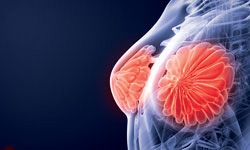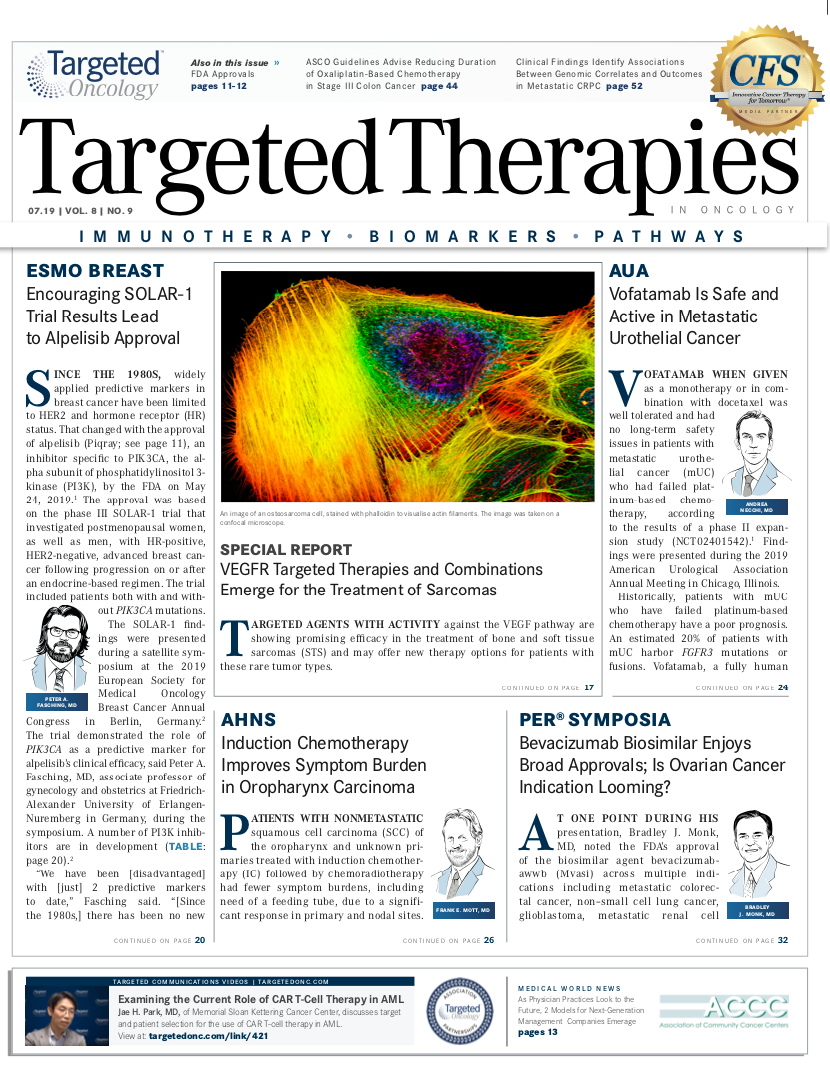Patients With MBC Have Reduced Toxicity Burden With Dual HER2-Targeted Therapy in the Front Line
Patients with HER2-positive metastatic breast cancer receiving frontline HER2-targeted therapy with pertuzumab and trastuzumab followed by T-DM1 in the second-line setting may be able to forgo chemotherapy without increasing the risk of early death, according to results from the phase II PERNETTA trial.

Patients with HER2-positive metastatic breast cancer receiving frontline HER2-targeted therapy with pertuzumab (Perjeta; PT) and trastuzumab (Herceptin) followed by T-DM1 (Kadcyla; adotrastuzumab emtansine) in the second-line setting may be able to forgo chemotherapy without increasing the risk of early death, according to results from the phase II PERNETTA trial.
“The main aim of this trial was to find out whether it is safe to omit chemotherapy in first- line treatment in the presence of a dual anti HER2-directed therapy followed by T-DM1,” said Patrik Weder, MD, of the Department of Oncology at Kantonsspital St. Gallen, Breast Centre St. Gallen, in Switzerland, to an audience at the 2019 European Society for Medical Oncology (ESMO) Breast Cancer Annual Congress held in Berlin, Germany.1
A total of 210 patients with metastatic, inoperable, locally advanced disease who had received no prior palliative treatment were randomized 1:1 to receive trastuzumab plus PT or the same dual blockade with chemotherapy, which could have included paclitaxel or vinorelbine for ≥4 months of therapy unless unacceptable toxicity or progressive disease occurred, followed by PT maintenance. Patients with hormone receptor (HR)positive disease should receive endocrine treatment (ET) when treated without chemotherapy in the PT-alone arm or with PT maintenance in the PT-plus- chemotherapy arm.
Following the first progression, both treatment arms received therapy with T-DM1 until the second progression. At second progression, treatment was at the discretion of the treating physician.
“New parenchymal CNS [central nervous system] metastases only did not count as progression requiring the initiation of second- or third-line treatment,” Weder said.
The primary endpoint was overall survival (OS) at 2 years. Secondary endpoints included progression-free survival (PFS), which was assessed for both first-line (PFS-1) and second-line therapy (PFS-2), and time to failure of strategy (TFS), which was assessed as progressive disease after both first- and second-line treatment or death.
Adverse events (AEs) and quality of life (QoL) of frontline therapy were also endpoints of inter- est. A subgroup analysis regarding HR status in frontline therapy was performed.2
Patient baseline characteristics were balanced between the PT (n = 105) and PT-plus-chemo- therapy (n = 105) arms. The median patient age was 58 years, most patients had an ECOG performance status ≤1 (92.4% vs 98.1%, respectively), and about one-third of patients in each arm were HR negative (35.2% vs 37.1%).
The data show that most patients did not receive ET during frontline treatment. However, Weder said that “not all patients in this group are represented [in the available data]. There will be more information about ET in more time because the endpoint of ET is collected at the end of first-line therapy; about 40% and 60% of patients [in the PT and PT-plus-chemotherapy groups, respectively] are still in first-line therapy.”
Efficacy data were presented last year at the ESMO 2018 Congress and showed that the median PFS-1 with PT was 8.4 months versus 23.3 months for PT plus chemotherapy.3How- ever, there was no difference between the 2 regimens for 2-year OS, and the updated results show rates of 77.1% and 76.2% in PT and PT plus chemotherapy, respectively.1
“No difference in 2-year OS was observed between the chemotherapy-free and the chemotherapy-containing arms, despite the shorter PFS of first-line therapy in the chemotherapy- free arm,” Weder said.
The PFS-2 was 7.0 months for PT versus 5.3 months for PT plus chemotherapy. Median TFS was 33.6 months versus 48.6 months, respectively.3
Analyses of PFS-1 and OS showed nearly identical responses in HR-positive and HR-negative patients. In patients who were HR positive, the median PFS-1 was 8.3 months and 23.7 months for patients receiving PT and PT plus chemo- therapy, respectively, versus 8.8 months and 22.2 months in patients who were HR negative. For 2-year OS, the rates were 75.0% and 74.2% in the HR-positive group and 81.1% and 79.5% in the HR-negative group, respectively.1
“Estrogen receptor and progesterone receptor status did not affect PFS during the first line of therapy or the OS at 2 years,” Weder said.
QoL was measured by the Functional Assessment of Cancer TherapyBreast Cancer Symptom Index, which uses 16 disease- and treatment-related symptoms and concerns to assess the patient’s status.2 Two single-item indicators also used were the overall treatment burden and the patient’s coping effort. Assessments were done before the initiation of treatment and every 3 months during first-line treatment up to 24 months.
In terms of treatment-related AEs (TRAEs), the PT-plus-chemotherapy arm almost always had a higher rate of toxicity than PT alone. The most notable TRAEs were diarrhea (67% vs 46%, respectively), fatigue (67% vs 50%), alopecia (31% vs 7%), nausea (31% vs 21%), and peripheral sensory neuropathy (30% vs 6%).
The investigators did a side-by-side comparison of AEs, divided into grades 1/2 and grades 3/4, and compared it with the patient’s assessment of the severity of their symptoms. Patient-reported symptoms showed that chemotherapy was associated with a higher treatment burden.
“We wanted to correlate the AEs and the patient-reported symptoms,” Weder said. “Even if we measure some AEs as grade 1 or 2, we as the treating physicians may not be so bothered, but our patients are.”
Weder said the investigators observed some improvements in QoL for the PT-alone arm, but the QoL of the patients in the PT-plus-chemotherapy arm remained stable over time. It is import- ant to continue to monitor these data as patient treatment progresses, he added.
“The omission of chemotherapy is an option in the presence of a dual anti-HER2directed therapy followed by T-DM1 without being at risk of early death. From a clinical point of view, this strategy may be considered for patients with low-to-intermediate tumor burden,” Weder concluded.
References
- Huober J, Ribi K, Weder P, et al. Pertuzumab (P) + trastuzumab (T) with or without chemotherapy both followed by T-DM1 in case of progression in patients with HER2-positive metastatic breast cancer (MBC) the PERNETTA trial (SAKK 22/10), a randomized open label phase II study (SAKK, UNICANCER, BOOG).Ann Oncol. 2019;30(suppl 3; abstr 150O_PR). doi: 10.1093/annonc/mdz100.001.
- Garcia SF, Rosenbloom SK, Beaumont JL. Priority symptoms in advanced breast cancer: development and initial validation of the National Comprehensive Cancer Network-Functional Assessment of Cancer Therapy-Breast Cancer Symptom Index (NFBSI-16).Value Health. 2012;15(1):183-190. doi: 10.1016/j.jval.2011.08.1739.
- Huober J, Weder P, Veyret C, et al. PERNETTA: a non-comparative randomized open label phase II trial of pertuzumab (P) + trastuzumab (T) with or without chemotherapy both followed by T-DM1 in case of progression, in patients with HER2-positive metastatic breast cancer (MBC): (SAKK 22/10/UNICANCER UC-0140/1207).Ann Oncol. 2018;29(suppl 8; abstr 288PD). doi: 10.1093/annonc/mdy272.280.
